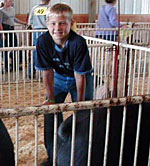By Laurel Druley, Minnesota Public Radio
August 20, 2001
|
|
RealAudio |
North America, Australia and New Zealand are the only areas that remain untouched by foot-and-mouth disease. Officials at Minnesota's county fairs, and soon the Minnesota State Fair, would like to keep it that way. This summer, many county fairs have posted signs and reminded folks about the danger of foot-and-mouth disease. When the Minnesota State Fair opens, there will be signs asking visitors who've travelled outside the United States within the past seven days, not to enter the livestock barns.
| |
|
|
|
||
His father, David Buck, says they'll sell the pigs instead of going to the State Fair competition this year. David Buck says he doesn't dwell on the foot-and-mouth scare, but is taking precautions to protect his cattle at home.
"I'm not real concerned at this point. It sticks in the back of your head. We have cattle as well. I'd hate to see that kind of devastation take place. It's a concern. I think the government's doing a good enough job to monitor and keep the stuff out of the country," he says.
Foot-and-mouth is a highly communicable viral disease that affects cloven-hoofed animals such as goats, pigs, sheep and cattle. It was eradicated in the United States in the 1920s, but a recent epidemic in the United Kingdom led to the slaughter of more than 4 million animals there. While not a danger to humans, the virus can spread from country to country on clothing and shoes. It can survive for days and then be transmitted elsewhere.
Jonathon DeMars, a 4-H Club pork ambassador, passes out ribbons to the Steele County winners. He says, just like any other year, participants must bring papers verifying veterinarians have examined animals before the competition. "There hasn't been as much concern in the last couple months as there was when the first outbreaks were coming out," according to DeMars. "Everyone is a little concerned and there are a lot of farmers that won't be taking their animals home after the fair because they want to make sure their animals don't have anything wrong with them."
Fair officials agree. They say the chance of the disease entering Minnesota during the fair is slim.
Steve Pooch, Assistant Manager of the State Fair competition, says about 1.7 million people come to the fair and about 600,000 go through the livestock barns. Pooch says it would be difficult to make all of those people clean their boots and shoes before entering the barns. He says he hopes the signs posted outside each of the eight barns will be sufficient.
"We're not officially enforcing it," he says. "People are on the honor system and we feel people are going to obey this. They don't want to be the person to bring it into the country. It would be difficult to enforce."
There are improved efforts this year to keep the fair safe, not just for the livestock, but for humans. Health officials have set up hand-washing stations outside the barns and food concession stands to remind visitors of good hygiene.
About 15,000 animals will arrive at the fairgrounds by Wednesday. And officials say, as always, they will all be examined by a veterinarian prior to the competition. But Steve Pooch says, they aren't testing for foot-and-mouth disease.

